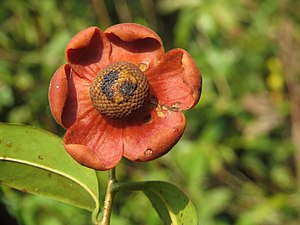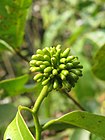Note: This is a project under development. The articles on this wiki are just being initiated and broadly incomplete. You can Help creating new pages.
Difference between revisions of "Uvaria narum"
(Created page with "{{stub}} ==Uses== {{Uses|}}, {{Uses|}}, {{Uses|}}, {{Uses|}}, {{Uses|}}, {{Uses|}}, {{Uses|}}, {{Uses|}}, {{Uses|}}, {{Uses|}}, {{Uses|}}.<ref name="Uses"/> ==Parts Used== {{...") |
|||
| (7 intermediate revisions by 2 users not shown) | |||
| Line 1: | Line 1: | ||
| − | + | [[File:Uvaria narum - South-Indian Uvaria flower at Mayyil (3).jpg|thumb|right]] | |
| + | '''Uvaria narum''' is a large, woody, climbing shrub. The plant is harvested from the wild for local use as a medicine and source of an essential oil. | ||
==Uses== | ==Uses== | ||
| − | {{Uses| | + | {{Uses|Various diseases}}.<ref name="Uses"/> |
==Parts Used== | ==Parts Used== | ||
| − | {{Parts Used| | + | {{Parts Used|Roots}}. |
==Chemical Composition== | ==Chemical Composition== | ||
| − | <ref name="chemical composition"/> | + | It contains On evapouration of the dry ether extract after removal of sodium sulphate, over a water bath yielded 0.9 g (0.11%) of the essential oil.<ref name="chemical composition"/> |
==Common names== | ==Common names== | ||
| − | {{Common names|sa=|en=|gu=|hi=|kn=|ks=|ml=|mr=|pa=|ta=|te=}} | + | {{Common names|sa=Nilavalli, Vallisakhotah|en=South-Indian uvaria|gu=|hi=|kn=ಕರೀಬಳ್ಳಿ Kariballi, ಉಣಾಮಿಣಿ ಗಿಡ Unamini gida|ks=|ml=Kooril, Narumpanal|mr=Kala apakara|pa=|ta=Puliccan|te=}}.<ref name="Common names"/> |
==Properties== | ==Properties== | ||
| Line 16: | Line 17: | ||
===Dravya=== | ===Dravya=== | ||
===Rasa=== | ===Rasa=== | ||
| − | |||
===Guna=== | ===Guna=== | ||
| Line 29: | Line 29: | ||
==Habit== | ==Habit== | ||
| − | {{Habit|}} | + | {{Habit|Climber}} |
==Identification== | ==Identification== | ||
===Leaf=== | ===Leaf=== | ||
| − | {{Leaf|||}} | + | {{Leaf|||}} |
===Flower=== | ===Flower=== | ||
| Line 48: | Line 48: | ||
==Mode of Propagation== | ==Mode of Propagation== | ||
| − | {{Propagation|}} | + | {{Propagation|Seeds}} |
==How to plant/cultivate== | ==How to plant/cultivate== | ||
| Line 54: | Line 54: | ||
==Commonly seen growing in areas== | ==Commonly seen growing in areas== | ||
| − | {{Commonly seen| | + | {{Commonly seen|Forests at elivations}}. |
==Photo Gallery== | ==Photo Gallery== | ||
<gallery class="left" caption="" widths="140px" heights="140px"> | <gallery class="left" caption="" widths="140px" heights="140px"> | ||
| − | + | Uvaria narum - South-Indian Uvaria flower at Mayyil (5).jpg | |
| + | Uvaria narum - South-Indian Uvaria flower at Mayyil (6).jpg | ||
| + | Uvaria narum - South-Indian Uvaria flower at Mayyil 2014 (1).jpg | ||
| + | File:Uvaria narum - South-Indian Uvaria at Mayyil (8).jpg | ||
| + | File:Uvaria narum - South-Indian Uvaria flower at Mayyil (1).jpg | ||
</gallery> | </gallery> | ||
==References== | ==References== | ||
<references> | <references> | ||
| + | <ref name="chemical composition">[https://shodhganga.inflibnet.ac.in/bitstream/10603/48728/10/10_chapter%203.pdf Chemical constituents]</ref> | ||
| − | <ref name=" | + | <ref name="Common names">[https://sites.google.com/site/indiannamesofplants/via-species/u/uvaria-narum Common names]</ref> |
| − | <ref name=" | + | <ref name="How to plant/cultivate">[Cultivation]</ref> |
| − | |||
<ref name="Uses">Indian Medicinal Plants by C.P.Khare</ref> | <ref name="Uses">Indian Medicinal Plants by C.P.Khare</ref> | ||
</references> | </references> | ||
==External Links== | ==External Links== | ||
| − | * [ ] | + | * [https://www.flowersofindia.net/catalog/slides/South-Indian%20Uvaria.html Uvaria narum on flowersofindia.net] |
| − | * [ ] | + | * [https://indiabiodiversity.org/species/show/246499 Uvaria narum on indiabiodiversity.org] |
| − | + | ||
[[Category:Herbs]] | [[Category:Herbs]] | ||
Latest revision as of 22:14, 31 August 2020
Uvaria narum is a large, woody, climbing shrub. The plant is harvested from the wild for local use as a medicine and source of an essential oil.
Contents
- 1 Uses
- 2 Parts Used
- 3 Chemical Composition
- 4 Common names
- 5 Properties
- 6 Habit
- 7 Identification
- 8 List of Ayurvedic medicine in which the herb is used
- 9 Where to get the saplings
- 10 Mode of Propagation
- 11 How to plant/cultivate
- 12 Commonly seen growing in areas
- 13 Photo Gallery
- 14 References
- 15 External Links
Uses
Parts Used
Chemical Composition
It contains On evapouration of the dry ether extract after removal of sodium sulphate, over a water bath yielded 0.9 g (0.11%) of the essential oil.[2]
Common names
| Language | Common name |
|---|---|
| Kannada | ಕರೀಬಳ್ಳಿ Kariballi, ಉಣಾಮಿಣಿ ಗಿಡ Unamini gida |
| Hindi | |
| Malayalam | Kooril, Narumpanal |
| Tamil | Puliccan |
| Telugu | |
| Marathi | Kala apakara |
| Gujarathi | |
| Punjabi | |
| Kashmiri | |
| Sanskrit | Nilavalli, Vallisakhotah |
| English | South-Indian uvaria |
.[3]
Properties
Reference: Dravya - Substance, Rasa - Taste, Guna - Qualities, Veerya - Potency, Vipaka - Post-digesion effect, Karma - Pharmacological activity, Prabhava - Therepeutics.
Dravya
Rasa
Guna
Veerya
Vipaka
Karma
Prabhava
Habit
Identification
Leaf
| Kind | Shape | Feature |
|---|---|---|
Flower
| Type | Size | Color and composition | Stamen | More information |
|---|---|---|---|---|
| {{{5}}} |
Fruit
| Type | Size | Mass | Appearance | Seeds | More information |
|---|---|---|---|---|---|
Other features
List of Ayurvedic medicine in which the herb is used
Where to get the saplings
Mode of Propagation
How to plant/cultivate
Commonly seen growing in areas
Photo Gallery
References
- ↑ Indian Medicinal Plants by C.P.Khare
- ↑ Chemical constituents
- ↑ Common names
- ↑ [Cultivation]
External Links
Categories:
- Ayurvedic Herbs known to be helpful to treat Various diseases
- Herbs with Roots used in medicine
- Herbs with common name in Kannada
- Herbs with common name in Malayalam
- Herbs with common name in Tamil
- Herbs with common name in Marathi
- Herbs with common name in Sanskrit
- Herbs with common name in English
- Habit - Climber
- Index of Plants which can be propagated by Seeds
- Herbs that are commonly seen in the region of Forests at elivations
- Herbs





